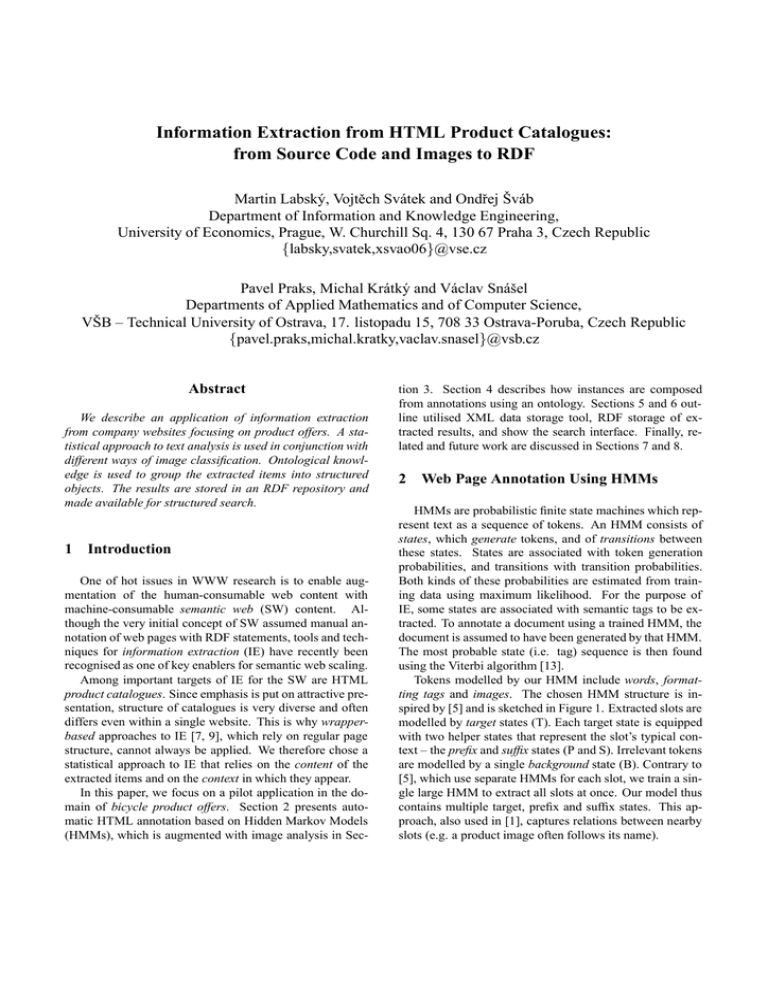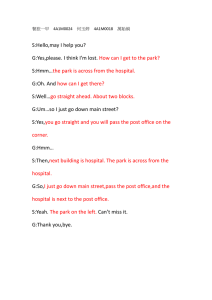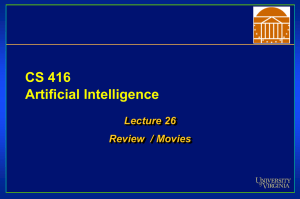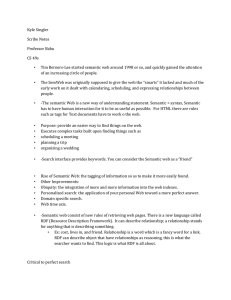Information Extraction from HTML Product Catalogues: from Source
advertisement

Information Extraction from HTML Product Catalogues:
from Source Code and Images to RDF
Martin Labský, Vojtěch Svátek and Ondřej Šváb
Department of Information and Knowledge Engineering,
University of Economics, Prague, W. Churchill Sq. 4, 130 67 Praha 3, Czech Republic
{labsky,svatek,xsvao06}@vse.cz
Pavel Praks, Michal Krátký and Václav Snášel
Departments of Applied Mathematics and of Computer Science,
VŠB – Technical University of Ostrava, 17. listopadu 15, 708 33 Ostrava-Poruba, Czech Republic
{pavel.praks,michal.kratky,vaclav.snasel}@vsb.cz
Abstract
We describe an application of information extraction
from company websites focusing on product offers. A statistical approach to text analysis is used in conjunction with
different ways of image classification. Ontological knowledge is used to group the extracted items into structured
objects. The results are stored in an RDF repository and
made available for structured search.
1 Introduction
One of hot issues in WWW research is to enable augmentation of the human-consumable web content with
machine-consumable semantic web (SW) content. Although the very initial concept of SW assumed manual annotation of web pages with RDF statements, tools and techniques for information extraction (IE) have recently been
recognised as one of key enablers for semantic web scaling.
Among important targets of IE for the SW are HTML
product catalogues. Since emphasis is put on attractive presentation, structure of catalogues is very diverse and often
differs even within a single website. This is why wrapperbased approaches to IE [7, 9], which rely on regular page
structure, cannot always be applied. We therefore chose a
statistical approach to IE that relies on the content of the
extracted items and on the context in which they appear.
In this paper, we focus on a pilot application in the domain of bicycle product offers. Section 2 presents automatic HTML annotation based on Hidden Markov Models
(HMMs), which is augmented with image analysis in Sec-
tion 3. Section 4 describes how instances are composed
from annotations using an ontology. Sections 5 and 6 outline utilised XML data storage tool, RDF storage of extracted results, and show the search interface. Finally, related and future work are discussed in Sections 7 and 8.
2 Web Page Annotation Using HMMs
HMMs are probabilistic finite state machines which represent text as a sequence of tokens. An HMM consists of
states, which generate tokens, and of transitions between
these states. States are associated with token generation
probabilities, and transitions with transition probabilities.
Both kinds of these probabilities are estimated from training data using maximum likelihood. For the purpose of
IE, some states are associated with semantic tags to be extracted. To annotate a document using a trained HMM, the
document is assumed to have been generated by that HMM.
The most probable state (i.e. tag) sequence is then found
using the Viterbi algorithm [13].
Tokens modelled by our HMM include words, formatting tags and images. The chosen HMM structure is inspired by [5] and is sketched in Figure 1. Extracted slots are
modelled by target states (T). Each target state is equipped
with two helper states that represent the slot’s typical context – the prefix and suffix states (P and S). Irrelevant tokens
are modelled by a single background state (B). Contrary to
[5], which use separate HMMs for each slot, we train a single large HMM to extract all slots at once. Our model thus
contains multiple target, prefix and suffix states. This approach, also used in [1], captures relations between nearby
slots (e.g. a product image often follows its name).
Figure 1. HMM architecture
To train our model, we manually annotated 100 HTML
documents with 15 semantic tags, which included bicycle
name, price, picture, its properties and components. The
documents belonged to different websites (there were typically only 3–4 documents from the same shop) and thus
had heterogenous formattings; the sites were picked from
the Google Directory Sports-Cycling-BikeShops-EuropeUK-England. Each document contained from 1 to 50 bicycle offers, and each offer at least contained the name and
price. There were 1034 offers consisting of 4126 annotations1 . Similarly to [11], preprocessing amounted to conversion to XHTML, and to rule-based replacement of several
frequently used patterns (such as “add to basket” buttons)
by dedicated tokens.
3 Impact of Image Classification
As a baseline approach, all images were represented by
identical tokens and product pictures could only be distinguished based on the context in which they appeared. Alternatively, we coupled the tagger with image classifiers to
provide it with more information. We used the following
features for classification: image size, similarity to training
product images, and whether there was more than one occurrence of the same image in the containing document.
3.1 Image size
We modelled size of bicycle images using a 2dimensional normal distribution N , only estimated from a
collection of positive training examples C. The dimensions
x, y of a new image I were first evaluated using the estimated normal density N . The density value was then normalised to (0,1) using the density’s maximum value, N max .
SizC (I) :=
N (x, y)
Nmax
(1)
An image I was classified as P os or N eg by comparing its
SizC (I) score to a threshold which was estimated by minimising error rate on an additional held-out set of images.
1 Training
data and IE demo are at http://rainbow.vse.cz.
Figure 2. Example of image similarity
Within our document collection, image size appeared to be
the best single predictor with error rate of 6.6%. However,
this was mainly due to our collection being limited to relevant product catalogues only. With more heterogenous data,
the actual image content will become necessary.
3.2 Image similarity
We experimented with a latent semantic approach to
measuring image similarity [12], previously applied to
similarity-based retrieval of images from collections. As an
example, see the four images in Fig. 2. The bike on image
(a) is a training case, with similarity 1 to itself; the similarity is high for another bike (b), lower for a moped (c), and
close to zero for a bicycle bag (d). We used this image-toimage similarity measure Sim(I, J) to compute Sim C (I),
the similarity of an image I to a collection of images C. In
our experiments, C contained the training bicycle pictures
(positive examples only). We compute Sim C (I) using Knearest neighbour approach by averaging the similarities of
the K most similar images from the collection.
K best images J∈C Sim(I, J)
(2)
SimC (I) =
K
Experimentally, we set K = 20 since lower values of K
lead to a decrease in robustness since Sim C (I) became too
sensitive to individual images J, and higher values did not
bring further improvement. The similarity-based classifier
achieved an error rate of 26.7%, with the decision threshold
for SimC (I) estimated again on held-out images.
3.3 Combined classifier
For the combined image classifier, we used as features
the above described size-based score Siz C (I), similarity
score SimC (I) and a binary feature indicating whether the
image occurs more than once in its document. Among classifiers available in the Weka [15] environment, the best error rate of 4.8% (without using held-out data) was achieved
by multilayer perceptron. All results were measured using
10-fold cross-validation on a set of 1, 507 occurrences of
999 unique images taken from our training documents. The
cross-validation splits were made at document level, i.e. all
images from one document were either used for training
or for testing. The first two classifiers used additional 150
held-out images to estimate their decision thresholds.
3.4 Using Image Information for Extraction
To improve IE results, we replaced each image occurrence in document with the predicted class of that image.
Since binary decisions would leave little room for the HMM
tagger to fix incorrect classifications, we adapted the abovedescribed classifiers to classify into three classes: P os,
N eg, and U nk. In this way, the HMM tagger learnt to tag
the P os and N eg classes correspondingly, and the tagging
of the U nk class depended more strongly on the context.
To build ternary size- and similarity-based classifiers, we
penalised each wrong decision with a cost of 1. The cost
of U nk decisions was set experimentally in the range (0, 1)
so that the classifier produced 5-10% of U nk decisions on
the held-out set. For the combined ternary classifier, we
achieved best results with a Weka decision list shown in Table 1. The list combines image occurrence count with predictions of the size- and similarity-based ternary classifiers,
denoted as class3Siz and class3Sim , respectively.
Table 1. Combined ternary classifier
Order Rule
1
class(I) = N eg if(occurences(I) > 1)
2
class(I) = P os if(class3Siz (I) = P os)
3
class(I) = U nk if(class3Siz (I) = U nk)
4
class(I) = U nk if(class3Sim (I) = P os)
5
class(I) = N eg
We evaluated IE results with all three ternary classifiers
and compared the results to the case where no image information was available. The new image information from the
combined classifier lead to an increase of 19.1% points in
picture precision and also to subtle improvements for other
tags. Improvements in precision, recall and F-measure for
3 frequent slots (product pictures, names and prices), on a
per-token basis, are shown in Table 2 for all three classifiers.
4 Ontology-Based Instance Composition
In order to get structured product offers, annotated attributes from previous section need to be grouped into (bicycle offer) instances. We use a simple sequential algorithm
that exploits constraints defined in a tiny presentation ontology (similar to IE ontologies in [4]) which encodes optionality and cardinality of attributes. These constraints partly
Table 2. IE results for selected tags
Prec Rec F-meas Prec Rec F-meas
No image information
Image similarity
Picture 67.8 87.1
76.2
78.5 87.3
82.7
Name
83.7 82.5
83.1
83.9 82.5
83.2
Price
83.7 94.4
88.8
84.0 94.4
88.9
Image size
Combined
Picture 85.6 88.4
87.0
86.9 89.1
88.0
Name
83.8 82.5
83.1
83.8 82.5
83.2
Price
84.0 94.4
88.9
84.0 94.4
88.9
Tag
pertain to the domain and partly to the way of presenting information in web catalogues. The algorithm adds an annotated attribute to the currently assembled instance unless it
would cause inconsistency; otherwise, the current instance
is saved and a new instance created to accommodate this
and the following items. Although the algorithm correctly
groups about 90% of attributes on hand-annotated data, on
noisy automatically annotated data its performance drops
to unsatisfactory 50%, often due to single missing or extra
annotations. This is a subject of ongoing research.
5 Generic System Infrastructure
For input data storage, we adopted the XML & fulltext indexing and query engine AmphorA. It stores each
root-to-leaf path in an XML document as a point in multidimensional space, where each dimension corresponds to
a level in the XML tree [8]. The full power of the XML
storage facility is not yet employed in the product catalogue
application. At the moment, AmphorA downloads chosen
websites, performs XHTML conversion and provides the IE
tool with XHTML sources. All components are wrapped as
web services, and called by a simple client application.
6 Result Storage And Retrieval
For compliance with the SW, we use an ontology based
on RDF Schema to store the extracted instances in RDF. As
RDF repository we chose Sesame 2 because of its SQL-like
declarative query language SeRQL, which is used by our
online search tool 3 . Its interface, shown in Fig. 3, allows
users to search for offers based on attribute values or ranges
and to further navigate through the repository.
2 http://www.openrdf.org
3 http://rainbow.vse.cz:8000/sesame/
problems mentioned in Section 4, heuristics from [3, 4] can
be applied. We also consider using an adapted Viterbi algorithm [1] respecting constraints defined in our presentation
ontology. Furthermore, the XML data query facility AmphorA will soon support a subset of XPath language, which
can be used by IE tool e.g. for efficient querying of multiple
documents from the same website. Finally, we plan to bootstrap [2] our limited training data using web search engines
and data picked from public resources.
The research is partially supported by the Czech Science
Foundation grant no. 201/03/1318.
References
Figure 3. Online search interface
7 Related Work
The number of existing web IE tools is quite high. Recently reported IE tools for SW are S-CREAM [6] and
MnM [14]. They attempt to integrate the processes of markup of training data and subsequent automated extraction
from new data. Armadillo [3] and Pankow [2], in turn,
rely on bootstrapping training data from existing resources,
which minimises human annotation effort.
In comparison, our project combines IE from text with
image analysis and integrates it with subsequent end-user
retrieval of extracted results. We also focus on company
websites, which are not frequently targeted by academic IE
research; presumably, they exhibit less transparent logical
structures and fewer data replications than e.g. computer
science department pages or bibliographies. Product websites were addressed by the CROSSMARC project [11], it
however did not seem to pay particular attention to presentation of extracted results in semantic web format. Its emphasis was on multi-linguality, and hence was more NLPoriented than our current study.
8 Conclusions and Future Work
We described an application of IE from HTML and images, leading to searchable RDF result repository. The application uses web services to integrate the IE tool with
XML storage system. In the IE tool, we plan to experiment with more advanced statistical models, such as Conditional Random Fields [10], which cope better with mutually dependent textual items. We also need to replace the
baseline implementation of ontology-based instance composition with a statistical parser that would be robust on automatically annotated data. For some of the layout-based
[1] V. Borkar, K. Deshmukh, and S. Sarawagi. Automatic segmentation of text into structured records. In: SIGMOD 2001.
[2] P. Cimiano and S. Staab. Learning by Googling. In: SIGKDD
Explorations 2004.
[3] F. Ciravegna, S. Chapman, A. Dingli, and Y. Wilks. Learning to Harvest Information for the Semantic Web. In: ESWS
2004.
[4] D.W. Embley, C. Tao, and S.W. Liddle. Automatically extracting ontologically specified data from HTML tables with
unknown structure. In: Proc. ER 2002.
[5] D. Freitag and A. McCallum. Information extraction with
HMMs and shrinkage. In: AAAI Workshop on Machine
Learning for IE 1999.
[6] S. Handschuh, S. Staab, and F. Ciravegna. S-CREAM – Semiautomatic CREAtion of Metadata. In: Proc. EKAW 2002.
[7] C.A. Knoblock, S. Minton, J.L. Ambite, N. Ashish, P.J. Modi,
I. Muslea, A.G. Philpot, and S.Tejada. Modeling Web Sources
for Information Integration. In: Proc. AAAI WI 1998.
[8] M. Krátký, J. Pokorný, T. Skopal, and V. Snášel. The Geometric Framework for Exact and Similarity Querying XML
Data. In: Proc. EurAsia-ICT 2002.
[9] N. Kushmerick, D. S. Weld, and R. Doorenbos. Wrapper Induction for Information Extraction. In: Proc. Intl. Joint Conference on Artificial Intelligence 1997.
[10] J. Lafferty, A. McCallum, and F. Pereira. Conditional Random Fields: Probabilistic Models for Segmenting and Labeling Sequence Data. In: Proc. ICML 2001.
[11] M.T. Pazienza, A. Stellato, and M. Vindigni. Combining ontological knowledge and wrapper induction techniques into
an e-retail system. In: ECML/PKDD workshop ATEM 2003.
[12] P. Praks, J. Dvorský, and V. Snášel. Latent semantic indexing
for image retrieval systems. In: Proc. SIAM Conf. on Applied
Linear Algebra 2003.
[13] L.R. Rabiner. A tutorial on hidden Markov models and selected applications in speech recognition. In: Proc. IEEE
1989.
[14] M. Vargas-Vera, E. Motta, J. Domingue, M. Lanzoni,
A. Stutt, and F. Ciravegna. MnM: Ontology Driven SemiAutomatic and Automatic Support for Semantic Markup. In:
Proc. EKAW 2002.
[15] I.H. Witten and E. Frank: Data Mining: Practical Machine
Learning Tools and Techniques with Java Implementations.
Morgan Kaufmann 1999, 1-55860-552-5.




